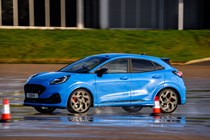Six car lengths. More specifically, 25 metres. That’s the difference in stopping distance from 70mph between a car fitted with brand-new tyres, and one with tyres worn down to the legal minimum tread depth. It’s a graphic illustration of the importance of keeping tabs on the condition of your car’s tyres.
We experienced for ourselves the difference in performance between brand new and barely legal tyres at Millbrook, courtesy of eBay. Besides the high-speed braking test, we also drove a tight circle and a slalom in a pair of Ford Puma STs. One was fitted with brand-new tyres, the other with tyres that just had the legal minimum tread depth.
It was a truly eye-opening, somewhat alarming experience that showed the extent to which your ability to drive safely is compromised by bad tyres.
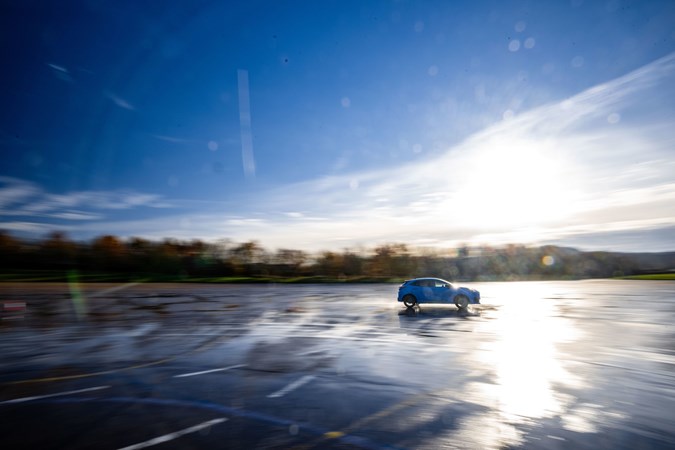
What is the minimum tread depth?
The UK’s legally required minimum tyre tread depth for cars is 1.6mm on all parts of the tyre. That’s virtually bald. Indeed, it’s so little tread that tyres worn down to that level stick out like a sore thumb – to the authorities and casual observers alike. By contrast, the best tyres typically have between 7mm and 9mm of tread when brand new.
Any car with 1.6mm of tread left will fail an MOT test and would be prohibited from use in a roadside inspection. Most MOT testers mark tyres with less than about 3mm of tread as an advisory item to be replaced as soon as possible. You can easily check your tyres with a tread depth gauge, or by using a 20p coin.
Why the minimum tread depth is so important
To provide the maximum possible grip, a tyre has to be completely slick – i.e. treadless. That allows as much rubber to be in contact with the road surface as possible. That’s why racing cars use slick tyres – they generate a vast of grip that allows the car to go as fast as possible. But even a tiny amount of water or muck on the road would cause a slick tyre to lose grip, at worst leading to an accident.
Tyre tread clears water and muck away from the rubber that’s in contact with the road so it can provide grip in all conditions, not just when the road’s warm and dry. As a tyre wears down and its tread depth reduces, its ability to provide all-weather grip is compromised. That’s why it’s better to buy new tyres than take a chance with a set of part-worn tyres.
We put the theory into practice and what we found out was highly educational.
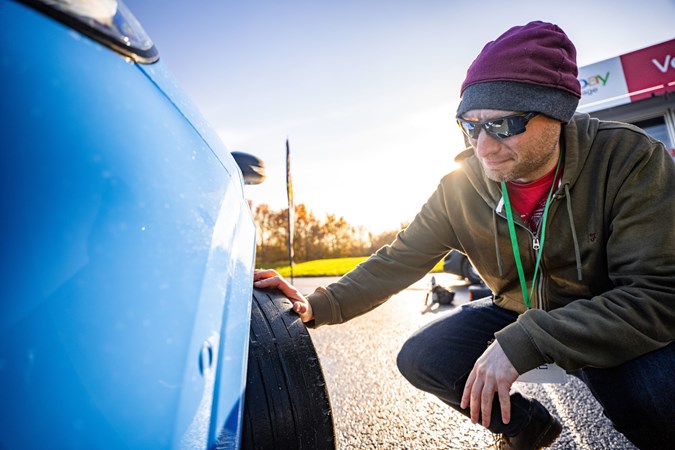
Braking in wet weather
The first test was an emergency stop from 70mph – the motorway speed limit – on a cold and wet concrete surface. The Puma fitted with brand new summer tyres came to halt hard, fast, straight and true. It’s always disconcerting to slam on a car’s brakes as hard as possible, but the stop felt entirely safe and secure.
It was an altogether different experience when we repeated the stop on tyres with 1.6mm of tread. The stopping distance was predictably longer, but just how much longer was a real surprise. At the first attempt, the car took a whopping 25 metres further to stop – we were genuinely wondering if it would halt before we ran out of space.
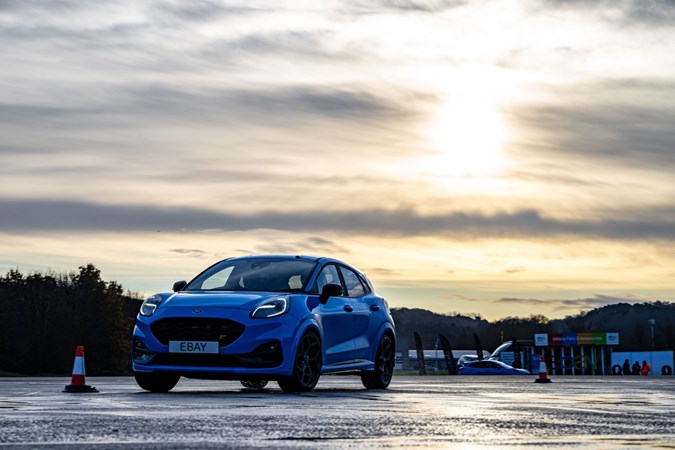
The ground had dried a bit for the second attempt, but the difference between good and bad tyres was still about 13 metres. On both occasions, the stop felt really very sketchy as the anti-lock brakes and stability control battled to keep the car on the straight and narrow.
Both stops on bad tyres could have resulted in a potentially serious collision with stationary traffic on a motorway. In the 25-metre scenario, the Puma was still travelling at nearly 30mph when it passed the point the car on good tyres had stopped. Any impact at 30mph could be very damaging – to the car and to you.
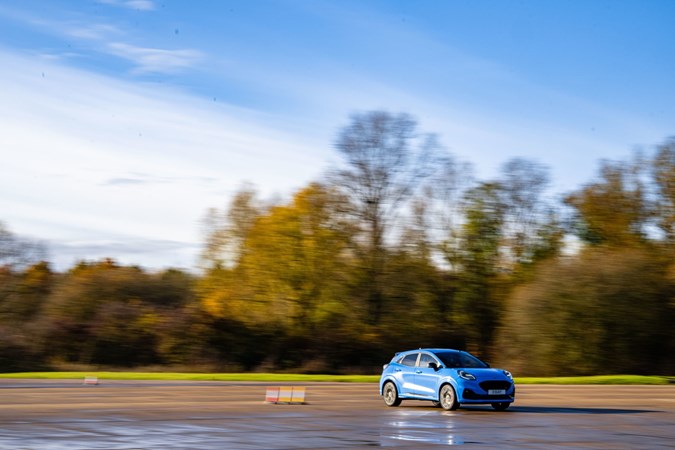
Cornering in wet weather
Imagine a roundabout, the kind you get at an A-road junction. Big and wide, you can easily get round them at 30mph. Driving round in a similar circle on the same wet concrete surface, the Puma on good tyres felt like it was on rails at 30mph. It would have gone a lot faster, but after half a dozen circuits we started to feel decidedly dizzy!
Next, we drove into a slalom at 25mph. Again, the car felt absolutely secure, going where it was pointed without a hint of delay or protest. The Puma was perfectly controlled, well within its limits and, at the end of the course, we’d only lost about 2mph – it was difficult to keep the throttle down!
The car on bad tyres provided an entirely different experience. In the circle test, the front tyres washed out into pronounced understeer at just 25mph – that is, the car went straight on, rather than turned. Then the back tyres slid into oversteer a couple of beats later.

In the Puma ST, the whole process was very progressive and predictable. But, in a different car, you could find yourself ploughing on with terminal understeer, or pointing the wrong way after the back end snapped round, with little to no warning.
The slalom was less wayward, but we could still feel the car’s driving assistance systems working overtime to keep the car going in the intended direction. The steering was less responsive and we felt it necessary to back off the throttle considerably, to the point we were barely exceeding 20mph at the end.
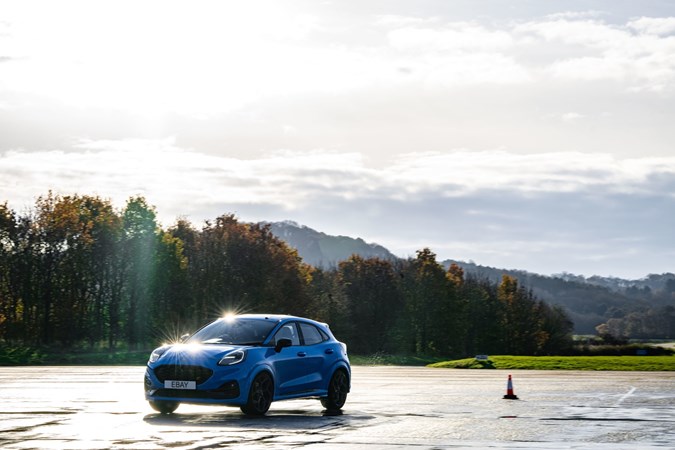
What did we learn?
These tests made the difference between how a car behaves on brand-new tyres and just-about-legal tyres starkly clear. In a controlled environment, it’s a fun experiment. In the real world, it could be the difference between getting home safely and not.
It also shows the importance of having the right tyres for the conditions. On the frigid November day of our tests, brand-new winter tyres may have performed even better.
eBay tyre expert, Hannah Gordon, said: ‘As a mechanic, I’ve witnessed the reluctance of people to address tyre damage promptly. People are often put off by the cost and think if they pass an MOT, they’re fine, which isn’t always the case. Braking distance and overall handling, especially in winter weather, can be seriously impacted by tyre health and tread depth.’
A survey commissioned by eBay backs up Hannah’s experience. It found that, despite checking the condition of your tyres being quite easy, 11% of drivers don’t feel confident about checking tread depth. More worryingly, 39% of respondents admitted that they only buy new tyres if they fail an MOT.
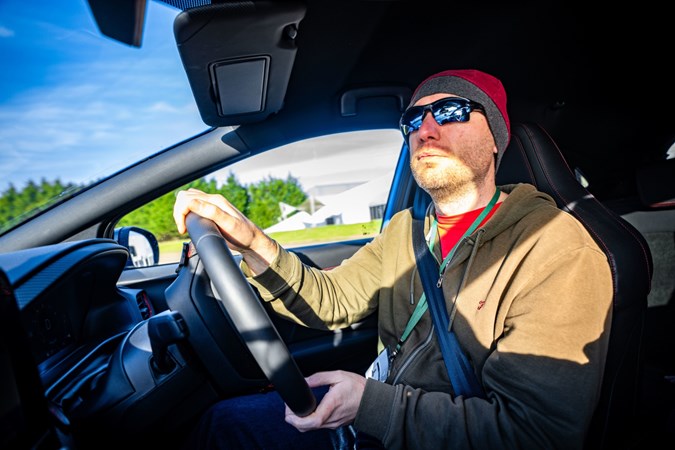
Young people are particularly prone to putting off buying new tyres, the survey finding that 44% of 18 to 24 year-olds had done so in the last three years. And 58% of that demographic felt garages overcharge for tyres.
Just so you know, we may receive a commission or other compensation from the links on this website - read why you should trust us.




